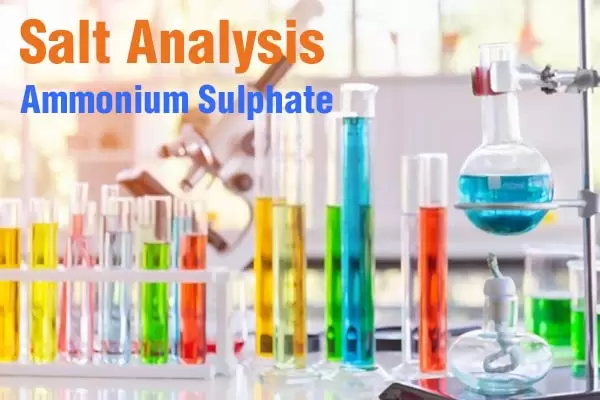Analysis of Ammonium Sulphate
- Posted by Chemistry instructor
- Categories General
- Date July 29, 2024
Analysis of Ammonium Sulphate
Ammonium Sulphate Chemical Composition:
Ammonium sulphate, a colorless crystal solid with the chemical formula (NH₄)₂ SO₄, has a rich history and diverse applications in various fields.
First synthesized in the 1800s, this inorganic salt is derived from ammonia and sulfuric acid and boasts versatility that has made it a fundamental element in multiple industries, ranging from agriculture to food production.
NH3 + H2SO4 → (NH4)2SO4
Role of Ammonium Sulphate in Plant Nutrition:
One of its primary uses is as a fertilizer, particularly valued in alkaline soils due to its ability to lower pH levels and increase the accessibility of nutrients for plants. By providing a vital source of nitrogen, essential for plant growth, ammonium sulphate aids in the healthy development of crops, ultimately resulting in increased yield and quality.
Its use spans across a wide range of crops, including cereals, vegetables, and fruit trees, showcasing its crucial role in sustainable agriculture.
Beyond its use in farming, it also plays a critical role in the food industry, serving as both a food additive and leavening agent. In baking, it enhances the color and texture of bread, resulting in a satisfying rise and a perfectly golden crust.
Also, in water treatment, it aids in the precipitation of impurities, purifying drinking water and ensuring consumer safety.
In the field of biochemical research, ammonium sulphate is an integral part of protein purification. Its ability to precipitate proteins at varying concentrations allows for the isolation of specific proteins for further study or pharmaceutical use. This application highlights the compound’s significance in advancing scientific understanding and innovation. From boosting agricultural productivity to its functions in food production and scientific research.
Ammonium sulphate serves as a testament to the extraordinary utility of chemical compounds. Its versatility and multifaceted nature make it a valuable resource in numerous sectors, supporting growth, promoting health, and driving innovation.
In Analysis (qualitative inorganic analysis) a step-by-step method is employed in detecting the cation (Ammonium ions) and anion (Sulphate ions) in the inorganic salt.

The Analysis of Ammonium Sulphate is part of the salt analysis and a schematic scheme is followed for the analysis of the given inorganic salt.
Anion and Cation Analysis of Ammonium Sulphate
The analysis of Ammonium Sulphate to be written in a practical file is mentioned below
| Test | Observation | Inference |
| Preliminary Test | ||
| Color | Colorless | Salts of Cu2+, Ni2+, Co3+, CrO4 2- , Fe3+ etc. may be absent |
| Ammonical odor | NH4 1+ ions may be present |
| Dry Test: | ||
Dilute Sulphuric acid test: Take 0.5 gm of Salt and then add Dilute H2SO4 | No Effervescence of CO2 | CO3 2- ions absent |
Concentrated Sulphuric Acid Test: Take 0.5 gm of salt and then add Concentrated H2SO4 dropwise from the side of the test tube | No gas evolved | Cl1-, Br1-, NO2 1-, CH3COO 1- ions absent |
Barium Chloride Test: Take 0.2 gm of salt and add BaCl2 Solution | White Crystalline ppt. | SO4 2- Ions present |
Confirmative test for Sulphate ions | ||
BaCl2 Test: Take 0.5 gm of Salt and add BaCl2 Solution | White crystalline ppt. insoluble in dilute HCl | SO4 2- Ions confirmed |
The acidic radical present in the salt is SO4 2– ion | ||
Test for Basic radicals (Wet Test) | ||
Solubility 2 gm of salt and add water | Clear solution (original Solution (O.S.)) | Water soluble salt. |
O.S. + Dilute NaOH Take 5 ml of O.S. and add Dilute NaOH solution if required heat gently | Ammonical odor | Group 1 Present NH4 1+ ions present
|
Confirmative Test for NH4 1+ ions | ||
O.S. + Conc. NaOH | Strong Ammonical Odor | NH4 1+ ions Confirmed |
O.S. + Nessler’s Reagent | Yellow-orange ppt’s | NH4 1+ ions Confirmed |
The Basic radicals are NH4 1+ ions | ||
The Salt is (NH4)2 SO4 (Ammonium Sulphate) | ||
You May Also like:
Biblography
ABOUT INSTRUCTOR
B.Sc (honors) Chemistry, M.Sc. (Organic Chemistry), Gold Medalist from Gujarat University Ahmedabad. Passionate educator, helping aspirants for IIT-JEE, NEET-UG, AP-Chemistry, IB-HL Chemistry, BIT-SAT, CBSE, and ICSE to achieve their ambitions
You may also like
Cracking BITSAT: Expert Tips and Strategies to Ace the Exam “Cracking BITSAT: Expert Tips and Strategies to Ace the Exam” – A blog post that …

Friedel Craft acylation Reaction
How to carry sulphonation of arenes
How to carry sulphonation of arenes Table of Contents Introduction How to carry sulphonation of benzene: Sulphonation of arenes, particularly benzene, is a fascinating reaction …
